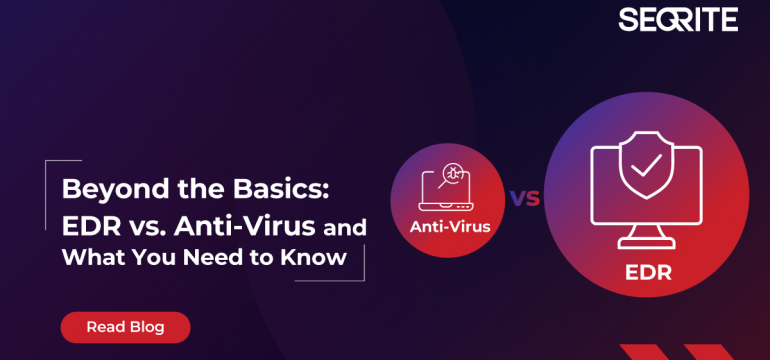Beyond the Basics: EDR vs. Antivirus and What You Need to Know
In this hyperconnected digital world, organizations face increasingly sophisticated cyber threats that demand advanced protection measures. The rise of endpoint detection and response (EDR) solutions has revolutionized how businesses safeguard their digital assets. As cyber-attacks grow more complex, traditional antivirus software often falls short of providing comprehensive cybersecurity. This has led to a shift towards more robust endpoint security solutions that offer real-time protection and incident response capabilities. Let’s understand what is EDR to learn more about EDR vs. Antivirus.
EDR solutions stand out for their ability to collect and analyze vast amounts of data from endpoints across an organization’s network. They provide IT administrators and security experts with powerful tools to detect, investigate, and respond to threats quickly and effectively. Unlike traditional antivirus programs, EDR platforms offer advanced threat-hunting capabilities, automated response mechanisms, and integration with extended detection and response (XDR) systems. By comparing EDR solutions with conventional antivirus software, we can gain insights into the key differences that make EDR an essential component of modern cybersecurity strategies.
Data Collection and Analysis
Antivirus Data Collection and Analysis
Traditional antivirus software employs two primary methods for data collection and analysis. The first approach involves scanning incoming programs and files and comparing them to a database of known viruses. The second method examines programs already present on the device, looking for suspicious behavior. This signature-based detection compares files to known malware signatures, requiring regular updates to the antivirus database to maintain effectiveness.
Heuristic-based detection, a more advanced technique, looks for similar patterns or tendencies in a file’s code rather than exact matches. This allows antivirus software to catch malware that signature detection might miss. Behavior-based detection goes a step further by examining how files and programs act, identifying anything out of the ordinary.
EDR Data Collection and Analysis
Endpoint Detection and Response (EDR) solutions take a more comprehensive data collection and analysis approach. EDR continuously monitors and records activities and events on endpoints in real-time, providing security teams with enhanced visibility. This includes tracking process executions, network connections, registry changes, file modifications, and other relevant system activities.
EDR systems analyse the behavior of processes and communications on endpoints to identify anomalies that could indicate a threat. This includes looking for unusual patterns such as sudden increases in data transmission, unexpected processes launching at startup, or unauthorized attempts to access sensitive data. Using machine learning and statistical modeling, EDR solutions can detect deviations from normal operations, identifying potentially malicious activities that don’t match known malware signatures.
EDR vs. Antivirus Data Collection and Analysis
The key difference between antivirus and EDR lies in data collection and analysis depth and breadth. While antivirus software primarily focuses on known malware signatures and basic behavioral analysis, EDR provides a more comprehensive and proactive approach.
EDR solutions offer:
- Continuous and real-time monitoring of endpoints
- Advanced behavioral analysis using machine learning
- Integration with external threat intelligence feeds
- Detailed context for security incidents
- Ability to trace the root cause of attacks
In contrast, antivirus software typically offers:
- Signature-based detection of known malware
- Basic heuristic and behavioral analysis
- Limited real-time monitoring capabilities
This enhanced data collection and analysis capability allows EDR to identify suspicious behavior quickly and respond with automated containment measures, making it more effective at detecting new threats that existing antivirus solutions may miss.
Automated Response
Antivirus Automated Response
Traditional antivirus software provides basic automated response capabilities to detect and remediate malware infections. Antivirus solutions can terminate malicious processes, quarantine suspicious files, and eradicate malware infections when a threat is identified. This approach focuses primarily on known threats and relies heavily on signature-based detection methods.
EDR Automated Response
Endpoint Detection and Response (EDR) solutions offer more advanced and comprehensive automated response capabilities. EDR takes a proactive approach to protect network endpoints from malware by monitoring the behavior of all applications on an endpoint or network device. This allows EDR to detect suspicious or anomalous activity that could signal an attack in progress.
When a threat is detected, EDR solutions can initiate a range of automated response actions:
Containment: EDR can automatically isolate compromised endpoints from the network, preventing the spread of malware. This process, known as “network containment,” allows organizations to take swift action by isolating potentially compromised hosts from all network activity.
Remediation: EDR tools can automatically clean up damage caused by an attack, including restoring data, removing malicious files, and undoing configuration changes.
Investigation: EDR solutions provide detailed reports about the attack, which can be used to inform future security strategies.
Rollback: Some EDR platforms offer the ability to quickly revert system configurations or files that were changed during the attack.
EDR vs. Anti-Virus Automated Response Comparison
The key differences in automated response capabilities between antivirus and EDR solutions are:
Scope of protection: While antivirus focuses primarily on known malware, EDR offers protection against a wider range of threats, including previously unknown or advanced attacks.
Response speed: EDR solutions can identify suspicious behavior quickly and respond with automated containment measures, often faster than traditional antivirus software.
Contextual analysis: EDR incorporates a range of security functions, enabling it to detect trends and other indicators of a successful incursion. This allows for more intelligent and context-aware automated responses.
Integration: EDR solutions often integrate with other security tools, such as Security Orchestration, Automation, and Response (SOAR) platforms, enabling automated playbooks and extending responses to hundreds of security and IT tools.
Advanced capabilities: Some EDR solutions, like Cortex XDR, use behavioral analytics, machine learning, and AI models to uncover threats from any source, including managed and unmanaged devices.
While antivirus software provides a front-line defense against known malware, EDR offers a more comprehensive and sophisticated approach to automated threat response. Organizations can benefit from combining both solutions to create a layered security strategy that addresses a wide range of potential threats.
Threat Hunting Capabilities
Antivirus Threat Hunting Capabilities
Traditional antivirus software has limited threat-hunting capabilities. Its primary focus is on detecting known malware signatures and basic behavioral analysis. Antivirus solutions typically rely on automated detection systems and do not provide the advanced tools necessary for proactive threat hunting.
EDR Threat Hunting Capabilities
Endpoint Detection and Response (EDR) solutions offer significantly more advanced threat-hunting capabilities compared to traditional antivirus software. EDR enables proactive threat hunting, where security analysts actively search for signs of compromise or suspicious behavior across endpoints. This approach helps organizations identify threats that may have evaded automated detection systems.
EDR provides continuous monitoring of endpoints, ensuring that networks are protected around the clock, even when security personnel are not actively monitoring. This continuous data collection and recording includes process executions, network connections, registry changes, file modifications, and other relevant system activities.
The threat-hunting process with EDR typically involves several key components:
Data Collection: EDR tools gather comprehensive endpoint data, providing visibility into all endpoints and network assets.
Analysis: Using machine learning and statistical modeling, EDR solutions can detect deviations from normal operations, identifying potentially malicious activities that don’t match known malware signatures.
Investigation: EDR provides tools for security analysts to remotely access affected endpoints, conduct detailed investigations, and manually remediate issues.
Timeline Creation: EDR systems provide a detailed timeline of events leading up to and following a security incident, allowing security teams to trace the root cause of an attack and understand the scope of a breach.
Automated Response: When a threat is detected, EDR tools can execute predefined response actions automatically, such as killing malicious processes, quarantining infected files, or isolating compromised endpoints from the network.
EDR vs. Antivirus Threat Hunting Capabilities Comparison
The key differences in threat-hunting capabilities between antivirus and EDR solutions are:
Proactive Approach: While antivirus software primarily reacts to known threats, EDR enables proactive threat hunting, assuming that adversaries may already be present in the system.
Data Analysis: EDR uses sophisticated algorithms and behavioral analysis to detect advanced threats like malware, ransomware, zero-day exploits, and Advanced Persistent Threats (APTs) that traditional antivirus software may miss.
Visibility: EDR provides comprehensive visibility into endpoint activities, allowing for more effective threat hunting.
Investigation Tools: EDR offers advanced tools for in-depth investigation and analysis, which are typically not available in traditional antivirus solutions.
Continuous Improvement: Insights gained from EDR investigations are used to refine detection algorithms, improve response strategies, and update security policies, making it particularly effective against sophisticated and evolving threats.
Conclusion
To wrap up, the comparison between EDR solutions and traditional antivirus software highlights the significant advancements in endpoint security. EDR’s comprehensive approach to data collection, analysis, and automated response provides organizations with a more robust defense against modern cyber threats. This enhanced capability has a substantial impact on an organization’s ability to detect, investigate, and respond to security incidents quickly and effectively.
In the end, while antivirus software still plays a role in basic malware protection, EDR solutions such as Seqrite EDR offer a more holistic approach to cybersecurity. The ability to perform proactive threat hunting, coupled with advanced automated response mechanisms, makes EDR an essential tool for organizations looking to strengthen their security posture. Want to start your journey to adopting Seqrite EDR? Contact us.




